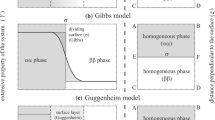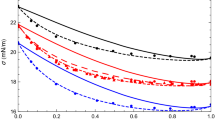Abstract
A model for the calculation of liquid–liquid interfacial energies is presented. It is based on the assumption that the interface can be treated as a separate thermodynamic phase. Its derivation has been performed in an analogous way as the derivation of the Butler equation for the surface tension of liquid alloys. It requires as input parameters the excess free energy and the compositions of the bulk phases as functions of temperature. In addition, it also requires the partial molar volumes of the components. Comparison with existing experimental data for Al–Pb, Al–In, and Cu–Co in a non-equilibrium state shows very good agreements. For Al–Bi, the experimental data are either over or underestimated by a factor of ≈1.7, depending on which of the two thermodynamic assessments is used. For the Al-based systems, the calculated Al-mole fraction in the interface layer is close to the arithmetic average of the Al-mole fractions of the bulk phases.






Similar content being viewed by others
References
Ratke L (1993) Immiscible liquid metals and organics. DGM Informationsgesellschaft mbH, Oberursel
Kaban I, Köhler M, Ratke L, Hoyer W, Mattern N, Eckert J, Greer AL (2011) Interfacial tension, wetting, and nucleation in Al–Bi and Al–Pb monotectic alloys. Acta Mater 59:6880–6889
Kaban I, Curiotto S, Chatain D, Hoyer W (2010) Surfaces, interfaces and phase transitions in Al–In monotectic alloys. Acta Mater 58:3406–3414
Kaban I, Gröbner J, Hoyer W, Schmid-Fetzer R (2010) Liquid–liquid phase equilibria, density difference, and Interfacial tension in the Al–Bi–Si monotectic system. J Mater Sci 45:2030–2034
Egry I, Ratke L, Kolbe M, Chatain D, Curiotto S, Battezatti L, Johnson E, Pryds N (2010) Interfacial properties of immiscible Co–Cu alloys. J Mater Sci 45:1979–1985. doi:10.1007/s10853-009-3890-0
Dörfler HD (2002) Grenzflächen und kolloid-disperse Systeme—Physik und Chemie. Springer, Berlin
Antion C, Chatain D (2007) Liquid surface and liquid/liquid interface energies of binary subregular alloys and wetting transitions. Surf Sci 10:2232–2244
Wynblatt P, Saul A, Chatain D (1998) The effects of prewetting and wetting transitions on the surface energy of liquid binary alloys. Acta Mater 46:2337–2347
Brillo J, Chatain D, Egry I (2009) Surface tension of liquid binary alloys. Int J Mater Res 100:53–58
Butler JAV (1932) The thermodynamics of the surfaces of solutions. Proc R Soc A135:348–374
Egry I, Brillo J (2009) Surface tension and density of liquid metallic alloys measured by electromagnetic levitation. J Chem Eng Data 54:2347–2352
Tanaka T, Iida T (1994) Application of a thermodynamic database to calculation of surface tension for iron base liquid alloys. Steel Res 65:21–28
Brillo J, Egry I (2005) Surface tension of nickel, copper, iron and their binary alloys. J Mater Sci 40:2213–2216. doi:10.1007/s10853-005-1935-6
Brillo J, Plevachuk Y, Egry I (2010) Surface tension of liquid Al–Cu–Ag ternary alloys. J Mater Sci 45:5150–5157. doi:10.1007/s10853-010-4512-6
Kaptay G (2008) A Calphad-compatible method to calculate liquid/liquid interfacial energies in immiscible metallic systems. Calphad 32:338–352
Kaptay G (2012) On the interfacial energy of coherent interfaces. Acta Mater 60:6804–6813
Press WH, Teukolsky SA, Vetterling WT, Flannery BP (1992) Numerical recipes in C—the art of scientific computing. Cambridge University Press, Cambridge
Yu SK, Sommer F, Predel B (1996) Isopiestic measurements and assessment of the AI–Pb system. Z Metallkd 87:574–580
Kim SS, Sanders TH (2006) Thermodynamic assessment of the metastable liquid in the Al–In, Al–Bi and Al–Pb systems. Modell Simul Mater Sci Eng 14:1181–1188
Mirkovic D, Gröbner J, Kaban I, Hoyer W, Schmid-Fetzer R (2009) Integrated approach to thermodynamics, phase relations, liquid densities and solidification microstructures in the Al-Bi-Cu system. Int J Mat Res 100:176–188
Bamberger M, Munitz M, Kaufman L, Abbaschian R (2002) Evaluation of the stable and metastable Cu–Co–Fe phase diagrams. Calphad 26:375–384
Cao W, Chen S, Zhang F, Wu K, Yang Y, Chang Y, Schmid-Fetzer R, Oates WA (2009) PANDAT software with PanEngine, panoptimizer and PanPrecipitation for materials property simulation of multi-component systems. Calphad 33:328–342
Kaptay G (2005) Modeling interfacial energies in metallic systems. Mater Sci Forum 473–474:1–10
Schenk T, Holland-Moritz D, Simonet V, Bellissent R, Herlach DM (2002) Icosahedral short-range order in deeply undercooled metallic melts. Phys Rev Lett 89:075507-1–075507-4
Assael MJ, Kakosimos K, Banish RM, Brillo J, Egry I, Brooks R, Quested PN, Mills KC, Nagashima A, Sato Y, Wakeham WA (2006) Reference data for the density and viscosity of liquid aluminium and liquid iron. J Phys Chem Ref Data 35:285–300
Assael MJ, Armyra IJ, Brillo J, Stankus SV, Wu J, Wakeham WA (2012) Reference data for the density and viscosity of liquid cadmium, cobalt, gallium, indium, mercury, silicon, thallium, and zinc. J Phys Chem Ref Data 41(33101):1–27
Assael MJ, Kalyva AE, Antonia KD, Banish RM, Egry I, Wu J, Kashnitz E, Wakeham WA (2012) Reference data for the density and viscosity of liquid antimony, bismuth, lead, nickel and silver. High Temp—High Press 41:161–184
Brillo J, Egry I, Matsushita T (2006) Density and excess volumes of liquid copper, cobalt, iron and their binary and ternary alloys. Int J Mat Res (formerly Z Metallkd) 97:1526–1532
Acknowledgements
We want to thank the following persons for their critical reading of the manuscript and for valuable suggestions: Philipp Kuhn, Dirk Holland-Moritz, Lorenz Ratke, and Matthias Kolbe.
Author information
Authors and Affiliations
Corresponding author
Rights and permissions
About this article
Cite this article
Brillo, J., Schmid-Fetzer, R. A model for the prediction of liquid–liquid interfacial energies. J Mater Sci 49, 3674–3680 (2014). https://doi.org/10.1007/s10853-014-8074-x
Received:
Accepted:
Published:
Issue Date:
DOI: https://doi.org/10.1007/s10853-014-8074-x




